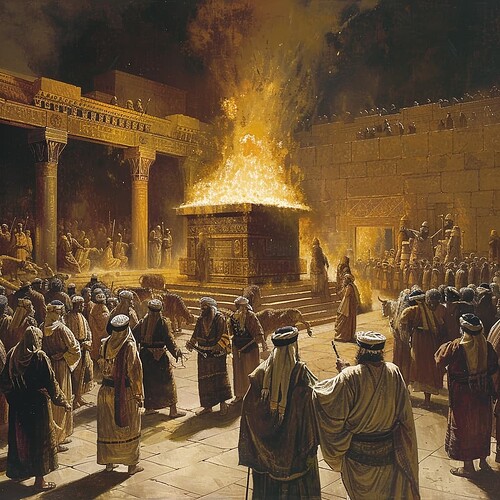 March 9: Leviticus 16: The Day of Atonement
March 9: Leviticus 16: The Day of Atonement
From ancient sacrifices to our modern spiritual journeys, Leviticus 16 is a cornerstone in understanding the concept of atonement in the Bible.
 Introduction
Introduction
Leviticus 16 is famous for it presents the Day of Atonement (Yom Kippur), a day deeply ingrained in Jewish tradition and hugely significant in our Christian beliefs about sacrifice and atonement.
 Aaron’s Atonement Offerings
Aaron’s Atonement Offerings
Leviticus 16 explains how Aaron, the high priest, was instructed to make atonement for the sins of the Israelites. Special sacrifices, rituals, and offerings were detailed for such an important day.
![]() Key Verse: Leviticus 16:30 “for on this day atonement will be made for you, to cleanse you. Then, before the LORD, you will be clean from all your sins.”
Key Verse: Leviticus 16:30 “for on this day atonement will be made for you, to cleanse you. Then, before the LORD, you will be clean from all your sins.”
 The Scapegoat
The Scapegoat
One of the most poignant insights is the use of two goats. One goat was sacrificed but the other, the scapegoat, was symbolically laden with the sins of the Israelites and sent into the wilderness; a powerful symbol of sins being carried away.
![]() Key Verse: Leviticus 16:22 “The goat will carry on itself all their sins to a remote place.”
Key Verse: Leviticus 16:22 “The goat will carry on itself all their sins to a remote place.”
 Key Themes and Reflections
Key Themes and Reflections
The theme of atonement dominates Leviticus 16. It reminds us of the weight of sin and the gravity of salvation, each one affirmed by the sacrifices made on Yom Kippur. The scapegoat’s imagery resounds with the concept of Christ bearing our sins and removing them “as far as the east is from the west” (Psalm 103:12).
 Today’s Application
Today’s Application
Though we no longer practice these rituals, their symbolic meaning should inspire humility and gratitude. Every sin, intentional or unintentional, has a cost and yet we are freed from this burden by the one-time ultimate sacrifice of Jesus Christ.
 Hidden Gem
Hidden Gem
The High Priest had to bathe and wear a simple white linen garment when he entered the Holy of Holies, symbolizing purity and humility. Thus, even amidst rituals, God’s focus remains on the heart’s condition.
 Reflective Q&A
Reflective Q&A
![]() How does the concept of Yom Kippur relate to Christ’s sacrifice?
How does the concept of Yom Kippur relate to Christ’s sacrifice?
A: Christ became our scapegoat and our sacrificial lamb, removing our sins.
![]() What does the two goats’ ritual teach us about the weight of sin and redemption?
What does the two goats’ ritual teach us about the weight of sin and redemption?
A: It teaches us about the tangible impact of sin and the profound gift of redemption.
![]() How can we apply the Atonement Day’s teachings to our modern life?
How can we apply the Atonement Day’s teachings to our modern life?
A: By being conscious of the cost of sin and the inexpressible value of God’s grace and mercy.
 Join the Discussion
Join the Discussion
How does understanding the symbols and rituals of the Day of Atonement deepen your insight into the cost of sin and Christ’s sacrifice?
 See You Tomorrow in Leviticus 17-18
See You Tomorrow in Leviticus 17-18
As we continue our journey, we’ll further explore God’s laws and their significance for the Israelites and us today.
Leviticus 16 challenges us to truly understand and appreciate the beauty of atonement and the profound love that fuelled the ultimate sacrifice on our behalf – Jesus Christ.
![]() Stay Updated: Don’t miss out on any updates or resources! Subscribe to our newsletter for all the Bible-in-a-Year posts and schedules delivered straight to your mailbox: Subscribe Here
Stay Updated: Don’t miss out on any updates or resources! Subscribe to our newsletter for all the Bible-in-a-Year posts and schedules delivered straight to your mailbox: Subscribe Here
![]() Explore Our Shop: Enhance your reading experience with related products from our store. Discover journals, mugs, and free digital downloads that resonate with this month’s themes: Visit Our Shop
Explore Our Shop: Enhance your reading experience with related products from our store. Discover journals, mugs, and free digital downloads that resonate with this month’s themes: Visit Our Shop
